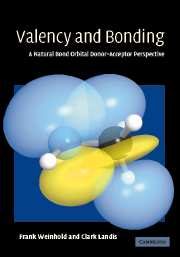Book contents
- Frontmatter
- Contents
- Preface
- 1 Introduction and theoretical background
- 2 Electrostatic and ionic bonding
- 3 Molecular bonding in s/p-block elements
- 4 Molecular bonding in the d-block elements
- 5 Supramolecular bonding
- Appendix A Methods and basis sets
- Appendix B Chemical periodicity
- Appendix C Units
- Chemical-species index
- Author index
- Subject index
Appendix B - Chemical periodicity
Published online by Cambridge University Press: 04 December 2009
- Frontmatter
- Contents
- Preface
- 1 Introduction and theoretical background
- 2 Electrostatic and ionic bonding
- 3 Molecular bonding in s/p-block elements
- 4 Molecular bonding in the d-block elements
- 5 Supramolecular bonding
- Appendix A Methods and basis sets
- Appendix B Chemical periodicity
- Appendix C Units
- Chemical-species index
- Author index
- Subject index
Summary
Introduction
Figure B.1 depicts the periodic table of the elements in the current IUPAC-approved form, with US-style assignments of group numbers as used throughout this book. This standard textbook table (STT) provides an accepted common vocabulary for the “row” (period) and “column” (group) assignments of each chemical element, and is thus an asset to clear pedagogical communication.
However, the STT somewhat muddles the natural groupings into s block, p block, d block, and f block of filling valence shells, which, from a fundamental perspective, is the most important feature of elemental electron configuration. The STT evolved from Mendeleev's original conception of serially ordering the elements in periodic tabular repeat patterns to reflect conspicuous chemical groupings (such as maximum oxidation number, physical state under standard-state conditions, and the like), long before the discovery of quantum theory and realization of the close associations between chemical and spectroscopic behavior. The STT chemical groupings reflect subtle biases toward ambient thermal conditions or the ambiguities arising from selected chemical criteria or the current extent of chemical knowledge. For theoretical purposes, certain alternative representations of chemical periodicity may therefore be advantageous in depicting the fundamental valence-electron occupancy patterns that underlie both chemistry and spectroscopy.
The theory of periodicity in electronic Aufbau of atomic configurations
According to the general Sturm–Liouville theory, the eigenvalues of any one-dimensional Schrödinger-type eigenvalue equation can be monotonically ordered according to the number of nodes (oscillations between negative and positive values) in the corresponding eigenfunctions.
- Type
- Chapter
- Information
- Valency and BondingA Natural Bond Orbital Donor-Acceptor Perspective, pp. 715 - 722Publisher: Cambridge University PressPrint publication year: 2005

